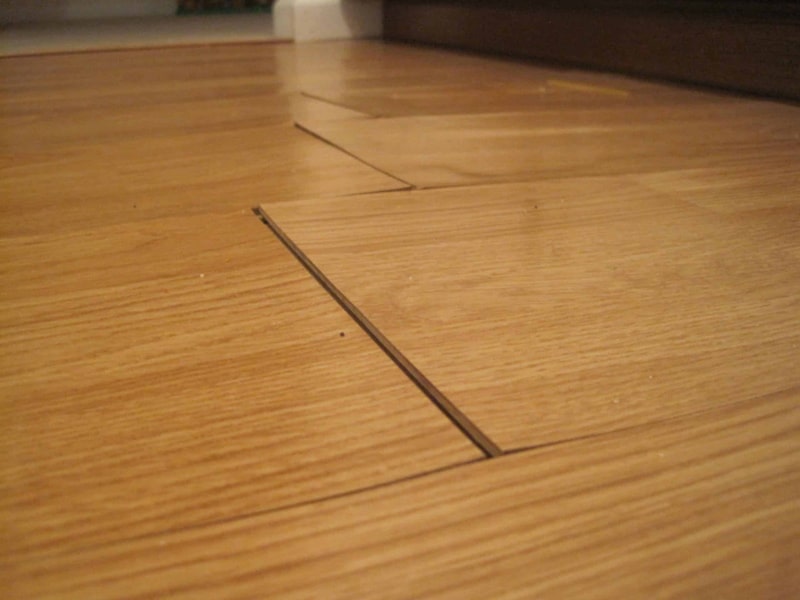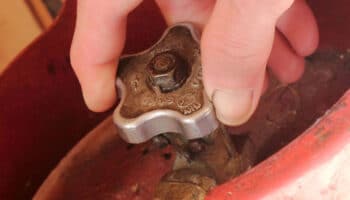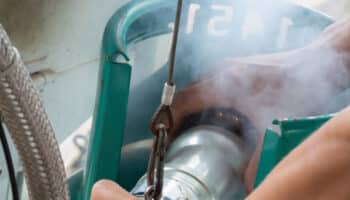We've independently reviewed this article to make sure it's as accurate as we can make it.
To find out more about our article creation and review process, check out our editorial guidelines.
Is there water under your laminate floor, and you’re growing concerned?
It’s totally understandable! While some floors, such as luxury vinyl plank flooring, ceramic flooring, or tile flooring, are water-resistant, laminate flooring can be easily damaged by the element.
Laminate flooring and water can lead to disaster in your home. If water gets underneath your laminate flooring, extensive water damage can result. Therefore, you must run water tests, dry the area, and possibly replace the flooring.
Luckily, you’ve come to the right place for answers. Below, you’ll find an article including 4 simple steps you can take to address the water under your laminate floor and prevent further damage.
Ready? Let’s dive in!
Laminate Flooring Disclaimer
It’s worth noting that some laminate flooring is actually water-resistant. Each board has a foam liner inside the snap lock, which forms a much better seal than a standard board. Home Depot sells water-resistant laminate flooring, so you might want to check it out.
If you already have water-resistant laminate flooring, you likely don’t need to worry about water damage.
Before we start, you should first make sure you’ve fixed whatever has caused the water damage! If you don’t address the source of the water leak first, water will reappear and undo all your hard work.
The Materials Needed
If there’s water under your laminate floor, you must ensure you have the right materials. First, you’ll need something you can use to remove excess water, such as a mop or a bunch of towels.
From what I’ve seen unless the damage is very extensive or water under your floorboards has been present for a while, there’ll be no need to replace the entire flooring. However, we won’t know for sure until we dig deeper.

4 Steps To Fix Water Under Laminate Flooring
In my experience, there are many things you can do to remove water under laminate flooring. You’ll need to put some elbow grease into the process, but I’m sure everything will return to normal before you know it.
Here’s what you must do.
Step 1: Mop Up Any Water That Is Still Present
To remove water under your floorboards, first, you need to make sure you mop up any water that is still present. Water under the laminate floor is less concerning when only the surface gets wet. However, the issue can become greater when the water seeps through the flooring’s cracks.
When there’s water on your laminate floor’s surface, it’s critical that you remove it immediately, as otherwise, the water will leak deeper, leading to serious damage.
Use a mop or a bunch of towels to dry up any water that could still be present. If you need to get a floor drying machine, look for a store that rents them out.
I find that installing laminate flooring in damp, leak-prone places, such as bathrooms, is a bad idea. For such areas in your home, I recommend other types of flooring, such as ceramic.
Step 2: Use a Vacuum to Remove Mold
If you have confirmed that you have water under your laminate flooring, you must take immediate action to prevent the problem from worsening. If you see laminate flooring wet on the edges, you need to use a wet-dry vacuum to extract any water that might still be present.
You may also need to pull up any shoe molding or quarter-round to complete the process.
Provided there’s still water under your floorboards, my usual advice is to remove the molding, the floorboards, and even the baseboard completely and replace the affected areas.
Step 3: Fix the Damage
After you have removed any of the damaged areas, it’s time to work on fixing them.
If you notice your hardwood flooring is crowning or cupping, you’ll need to contact a professional who can assist you. I should mention that, as opposed to hardwood flooring, laminate flooring can’t be saved when there’s excess water damage.
Hardwood floors can be sanded down to reverse water damage, which sadly can’t be done with laminate flooring.

Now, don’t lose hope. When laminate flooring is installed, there are typically leftover laminate boards for situations like the one you’re currently in. If a third party installed your laminate flooring, chances are they left spare floorboards in your garage or attic.
If you’re not comfortable replacing your laminate boards, you’ll want to contact a professional company that can help you.
Step 4: Make Sure the Area Is Dry Before Installing the Boards
The last step to fixing water under your laminate floor is to ensure you’re placing the replacement floorboards on a dry surface.
If you rely on a professional company to help you put the laminate flooring down, they likely already ensure the area is completely dry. However, if you’re laying down the floorboards yourself, double-check for any leftover moisture.
If you’re placing laminate flooring in your bathroom and the floorboards are thinner or thicker than the toilet flange, it could lead to a leak each time the toilet is flushed.
To ensure dry surfaces before placing the new floorboards, you can leave the area to dry for a couple of days. Remember that you may also have to apply new quarter-round or shoe molding, so ensure you have plenty of the material.
Find the Right Flooring For Your Home
If you consistently have water under your floorboards, you may want to install something more water-resistant. Especially if your laminate flooring is located in humid, water-ridden areas, such as a bathroom with a shower.
Luxury vinyl plank is water-resistant and a good alternative to laminate flooring. Even though vinyl plank can get slippery if it gets wet, you won’t have to worry about water damage so much. You may also want to talk to a professional flooring company about other options that could be more moisture-resistant.
Ceramic and tile are also great choices. If you take the time to evaluate your options carefully, you should be able to find something that is more water-resistant than laminate flooring.
Fixing Water Under Your Floorboards
These are a few of the most important points you need to remember when it comes to laminate flooring and water. Spills can happen occasionally, but remember that some floors are more susceptible to spills than others.
If you have laminate flooring in your home, it cannot get wet. If moisture gets around or underneath the laminate flooring, you must completely dry the area and replace the floors.
While it’s true that laminate flooring can handle water on the surface, you still need to clean up the spill quickly. Water can seep through, and it might be able to get underneath the flooring if you let it sit there. Make sure you use towels and mops to remove the moisture completely.
Thanks for reading. If this article was useful and informational, please consider checking out our other related articles below and subscribing to our newsletter.
Have a great day!
-Craig.
Frequently Asked Questions
What’s the Average Lifespan of Laminate Flooring?
Anywhere between 10-25 years.
Laminate flooring’s lifespan depends greatly on the quality of the materials used in its manufacturing, foot traffic, and maintenance.
How to Maintain Laminate Flooring?
The easiest way to maintain laminate flooring in good condition is to clean it regularly. Remove any excess dust or debris that can scratch the flooring when you walk on it.
Avoid using steam and heat to clean your laminate flooring, and use a damp mop without too much water.
Can I Install Laminate Flooring Over Existing Floors?
Absolutely!
Laminate flooring can be installed over existing floors; however, it’s critical that the base flooring is smooth and level to ensure the best results.








